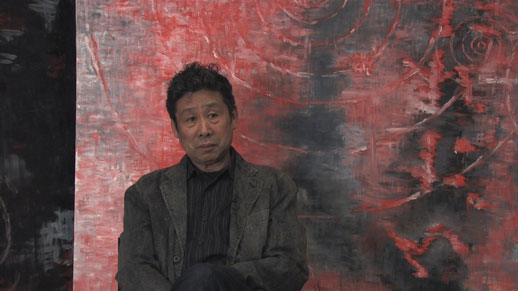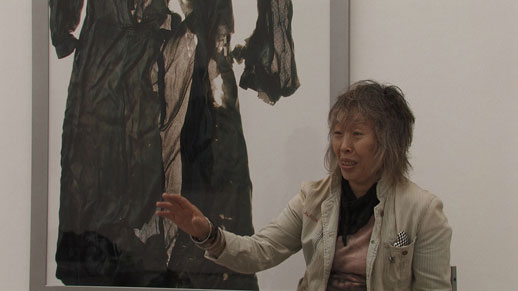ANPO: Art X War
Standing before the Futenma military installation in Okinawa, a curator from the Sakima Art Museum asks a group of young students: “Do you know what the U.S.-Japan Mutual Security Treaty is?” As they watch war planes soaring overhead, the students shake their heads sheepishly. “The treaty is called ANPO for short,” the curator resumes. “This place is full of ANPO. Here in Okinawa, you can see ANPO.”
This brief scene conveys one of principal concerns of Linda Hoaglund’s documentary “ANPO: Art X War”: to explore the relationship between politics and everyday life, between Japan’s immediate postwar and the present day, a relationship that is both translucent and opaque. In this sense, Hoaglund’s film is a work of historical memory, narrated using an extraordinary series of photographs, forgotten paintings, films, and the startling testimony of those who created them. Dating from 1960, the legacy of ANPO for postwar Japan has been profound. It not only illuminates “the Okinawa problem”, but the artistic and popular imagination of the postwar generations.
The first two sequences of the film quickly establish its scope: we are offered sustained views of Kikuji Yamashita’s “Tale of New Japan” (1954), and Makoto Aida’s “Map of an Air Raid on NYC” (1996). Unequivocally, this is not a film focused on Okinawa, but rather the point of departure for a meditation on Japan’s place in the postwar world. The line through history that connects these two paintings spans four decades, crossing ANPO in 1960. Hoaglund’s innovation is to examine this history through the lens of art, and equally to gaze upon these artworks through the lens of history, illuminating secret correspondences between past and present, between imagination and reality. In this regard, the film’s title understates its ambition, for “ANPO” explores not so much art and war, as the artistic expression of resistance to war. More precisely: how have Japanese artists represented this resistance?

The ANPO treaty and the events of 1960 are not simply a chapter in postwar history, but a key to understanding the present geopolitical reality of Japan. Today, its effects can be felt both at the level of daily life, as well as that of the deeper spiritual malaise that is tied to Japan’s relationship with the United States. Walking the evening streets of Yokosuka, photographer Miyako Ishiuchi asks: “Why are there so many bases here?” Her question reverberates urgently throughout the film. Indeed, sixty-five years after the end of the Pacific War, and nearly twenty years after the end of the Cold War, over 35,000 American military personnel remain stationed at 90 U.S. bases in Japan, the majority being located in Okinawa. Since the putative end of the Occupation in 1952, some two-hundred thousand accidents or crimes involving base personnel have been recorded, in which over one thousand Japanese civilians have died. Today, Japan remains a vassal state [zokkoku] in the American empire.
Conspicuously, Hoaglund doesn’t invoke any of these statistics to alert us to the effects of an endless de facto Occupation, instead showing us direct photographic evidence. She understands intuitively that a powerful moment captured on film can be more lucid and more haunting than sound-bite facts and figures. From Ishiuchi’s photo studies of Yokosuka, we catch glimpses of young women moving furtively through the sordid base-town ambiance of bars and snack clubs, whose sex- and war-themed marquees are decorated like fighter planes. Kikuji Yamashita’s “Tale of New Japan” shows the postwar landscape as a welter of commerce strung together by power lines, all being up-ended by collage-aesthetic monsters. Evoking the infamous Girard incident, Hiroshi Nakamura’s phantasmagorical paintings of weapons and the civilians that they kill, transform the crumpled bodies of victims into abstracted, oblate forms. Photographer Mao Ishikawa’s “Fences Okinawa” series points to the contradictory function of the military installations: ostensibly for the defense of Japan, but in fact serving as posts for global military operations in Iraq, Afghanistan, and beyond.

In 1960, ANPO became the flash point for the greatest popular uprising in modern Japan. Hoaglund carefully builds the tension around the anti-ANPO demonstrations, drawing upon Hiroshi Hamaya’s remarkable photo series “Days of Rage and Grief”. In parallel, painters Nakamura and Katsuragawa recount how the artistic problem becomes one of representing political impasse. In an age when the mass media has taken hold of the national consciousness, “ANPO” shows both how artists and photographers created critical images of these conflicts, and how they represented the experience of defeat. Not simply the defeat that ended the Pacific War, but the defeat of popular democracy in Japan, a vital movement that was subdued by the 1955 System. In word and image, “ANPO” vividly explores how these events transformed the artistic imagination, how the interiorization of the creative process, in art and in labor, yields a new relationship with the real.
“ANPO: Art X War” offers a stunning journey through postwar Japanese art and politics, an alternative history that ultimately rejoins the political imaginary of the present day.
“ANPO: ART X WAR” USA/Japan (2010) (89 minutes)
Opening at Shibuya UPLINK on September 18th.
An English-subtitled version will be screened every day at 16:30 until September 24. From September 25 the last showing on Sundays will be subtitled.
Produced and directed by Linda Hoaglund.
With appearances by: Tadanori Yokoo, Eikoh Hosoe, Hiroshi Nakamura, Makoto Aida, Miyako Ishiuchi, Kikuji Yamashita, Tatsuo Ikeda, Tokiko Kato, Mao Ishikawa, Shomei Tamotsu, and Kazuyoshi Kushida.
M. Downing Roberts
M. Downing Roberts



